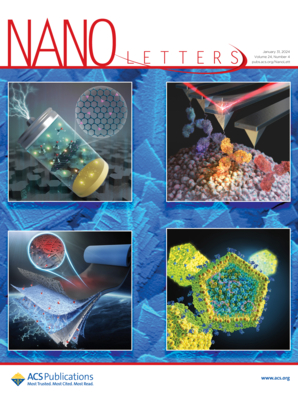Annealing Effects on Cu Migration in the Colloidal Synthesis of Pd-Chalcogenides Nanoheterostructures.
IF 9.1
1区 材料科学
Q1 CHEMISTRY, MULTIDISCIPLINARY
引用次数: 0
Abstract
Heterostructuring nanocrystals into a modular metal-semiconductor configuration enables tunable and novel functionalities. Such combinations at the nanoscale equip hybrid structures with unique electronic, optical, and catalytic properties unobserved in single-phase materials. Here, we report the hot-injection synthesis of Pd-Cu3Pd13S6.65Te0.35 nanoheterostructures (NHCs) from PdCu nanoalloy seeds. First, the growth of Pd-rich chalcogenide nanocrystals was initiated over the preformed PdCu surface through simultaneous sulfidation and tellurization, followed by their transformation into Pd-Cu3Pd13S6.65Te0.35 NHCs. By strategically employing moderate-temperature annealing, we achieved the complete migration of Cu+ due to the higher reactivity of Cu in comparison to Pd at that temperature, establishing a novel mechanistic relationship between cation mobility and temperature. This strategy enables controlled semiconductor domain formation and targeted metal migration. The NHCs showed efficient and stable electrocatalytic hydrogen evolution with low Tafel values in acidic media, outperforming conventional nanoelectrocatalysts. Computational analysis identified the active sites responsible for the observed catalytic performance.退火对钯硫族化合物纳米异质结构胶体合成中Cu迁移的影响。
异质结构纳米晶体成为模块化金属半导体配置,可以实现可调和新颖的功能。这种纳米级的组合使混合结构具有在单相材料中观察不到的独特的电子、光学和催化性能。本文报道了用PdCu纳米合金种子热注射合成Pd-Cu3Pd13S6.65Te0.35纳米异质结构(NHCs)。首先,在预制的PdCu表面,通过同时硫化和碲化引发富pd硫族化物纳米晶体的生长,然后转化为Pd-Cu3Pd13S6.65Te0.35 NHCs。通过有策略地采用中温退火,我们实现了Cu+的完全迁移,因为在该温度下Cu的反应活性高于Pd,建立了阳离子迁移率与温度之间的新型机制关系。这种策略可以控制半导体畴的形成和有针对性的金属迁移。NHCs在酸性介质中表现出高效稳定的电催化析氢性能,具有较低的Tafel值,优于传统纳米电催化剂。计算分析确定了负责观察到的催化性能的活性位点。
本文章由计算机程序翻译,如有差异,请以英文原文为准。
求助全文
约1分钟内获得全文
求助全文
来源期刊

Nano Letters
工程技术-材料科学:综合
CiteScore
16.80
自引率
2.80%
发文量
1182
审稿时长
1.4 months
期刊介绍:
Nano Letters serves as a dynamic platform for promptly disseminating original results in fundamental, applied, and emerging research across all facets of nanoscience and nanotechnology. A pivotal criterion for inclusion within Nano Letters is the convergence of at least two different areas or disciplines, ensuring a rich interdisciplinary scope. The journal is dedicated to fostering exploration in diverse areas, including:
- Experimental and theoretical findings on physical, chemical, and biological phenomena at the nanoscale
- Synthesis, characterization, and processing of organic, inorganic, polymer, and hybrid nanomaterials through physical, chemical, and biological methodologies
- Modeling and simulation of synthetic, assembly, and interaction processes
- Realization of integrated nanostructures and nano-engineered devices exhibiting advanced performance
- Applications of nanoscale materials in living and environmental systems
Nano Letters is committed to advancing and showcasing groundbreaking research that intersects various domains, fostering innovation and collaboration in the ever-evolving field of nanoscience and nanotechnology.
 求助内容:
求助内容: 应助结果提醒方式:
应助结果提醒方式:


